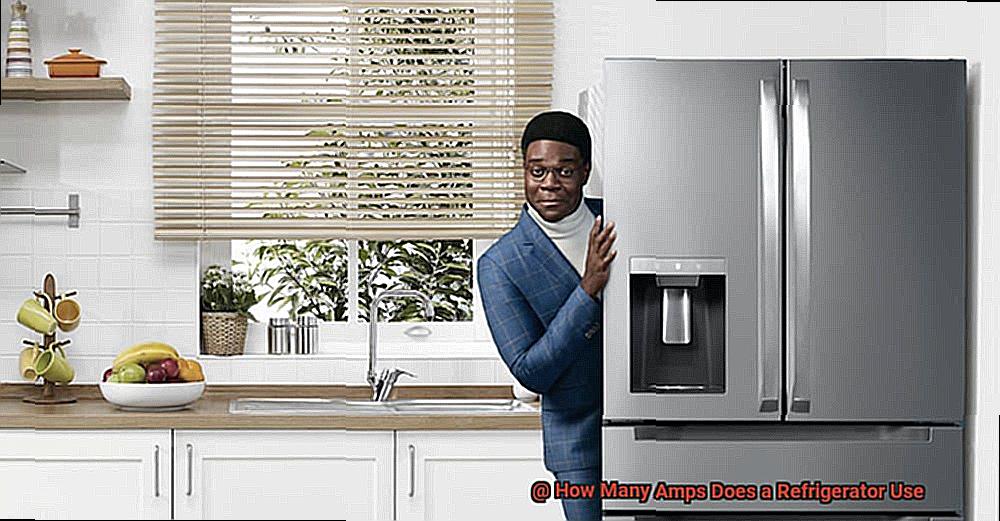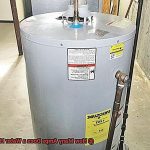Are you tired of being hit with high energy bills every month? Do you want to find a way to cut back your expenses without sacrificing your comfort? Well, look no further because we have the solution for you. By understanding how many amps a refrigerator uses, you can save money and become more environmentally conscious.
Refrigerators are one of the most important appliances in our homes. They keep our food fresh and our drinks cold, but they can also be a major energy sucker. That’s why it’s crucial to know how many amps your fridge consumes.
In this blog post, we’ll cover everything you need to know about how many amps a refrigerator uses. We’ll explain what amps are and how they relate to energy consumption. Plus, we’ll discuss the various factors that affect a refrigerator’s energy usage such as its size, age, and features.
But that’s not all. We’ll also give you some valuable tips and tricks to reduce your fridge’s energy consumption without compromising on its performance.
So come along with us on this exciting journey towards becoming an expert in energy savings and living a more sustainable lifestyle. Trust us; by the end of this article, you’ll be amazed at how much money and energy you can conserve just by understanding how many amps your fridge uses.
Average Amps Used by Refrigerators
Contents
- 1 Average Amps Used by Refrigerators
- 2 Factors that Affect Refrigerator Energy Consumption
- 3 How to Determine How Many Amps Your Refrigerator Uses
- 4 Different Types of Refrigerators and Their Amp Usage
- 5 Benefits of Knowing Your Fridge’s Amp Usage
- 6 Tips for Reducing Your Refrigerator’s Energy Consumption
- 7 Conclusion
Amps, or amperes, are units of electrical current that indicate how much electricity is flowing through a circuit. In terms of refrigerators, amps can help us determine how much power the appliance is consuming at any given time.
On average, most refrigerators use between 3 and 6 amps of electricity, although this may vary depending on the size and type of refrigerator, its age, and energy efficiency rating. For instance, a compact refrigerator may use only around 1 amp, while a large side-by-side refrigerator equipped with ice and water dispensers may utilize closer to 10 amps.
It’s worth noting that the amps used by a refrigerator can fluctuate throughout the day as the appliance cycles on and off to maintain its temperature. Additionally, factors like the ambient temperature and humidity in the room where the refrigerator is located can also impact its energy usage.
To get a more accurate idea of how many amps your refrigerator is using, you can use an amp meter or power meter to measure its electrical current. These devices are readily available online or at hardware stores for around $20-$50. Simply plug your refrigerator into the meter and it will display the real-time amps being used.
Understanding the average amps used by your refrigerator is essential because it allows you to make informed decisions about energy usage and potentially reduce your monthly electricity bill. By opting for an energy-efficient model or making simple adjustments to your usage habits, you can help minimize your environmental impact and save money in the long run.
By being mindful of your fridge’s energy consumption and choosing an eco-friendly appliance, you can contribute towards building a sustainable future.
Factors that Affect Refrigerator Energy Consumption
It can account for up to 15% of your monthly energy bills. But don’t worry, understanding the factors that affect a refrigerator’s energy consumption can help you save money and reduce your carbon footprint.

Let’s dive deeper into the five factors that affect refrigerator energy consumption.
Firstly, the size and capacity of your refrigerator play a significant role in its energy consumption. Larger refrigerators typically use more energy than smaller ones, so it’s essential to choose a size that suits your needs. Additionally, storing fewer items in your refrigerator can help reduce its energy consumption.
Secondly, older refrigerators tend to use more energy than newer models, even if they have the same size and capacity. This is because newer models are designed with energy-saving features such as improved insulation and more efficient compressors. Moreover, regular maintenance of your refrigerator can also help improve its efficiency and reduce its energy consumption.
Thirdly, the temperature settings of your refrigerator can significantly affect its energy consumption. Keeping the recommended temperature for your fridge (between 35-38°F) and freezer (0°F) can ensure optimal performance and reduce energy consumption.
Fourthly, the location of your refrigerator can also impact its energy consumption. Placing it near a heat source such as an oven or window that receives direct sunlight can cause it to work harder to maintain the desired temperature, leading to higher energy consumption.
Lastly, your usage habits can also affect your refrigerator’s energy consumption. Opening the door frequently or leaving it open for extended periods can increase its workload, resulting in higher energy consumption. It’s essential to minimize the frequency and duration of opening the door and ensure that it’s always closed tightly.
In conclusion, by considering these factors and taking simple steps to improve your refrigerator usage habits, you can significantly reduce your monthly energy bills and contribute to a sustainable environment. Remember, making eco-friendly choices and working towards a greener world starts at home.
How to Determine How Many Amps Your Refrigerator Uses

Why It’s Important to Know Your Refrigerator’s Amps
Do you know how much energy your refrigerator consumes? Knowing the amperage of your refrigerator can have a significant impact on your energy bills and carbon footprint. By being aware of how many amps your fridge uses, you can make informed decisions about its energy consumption and take steps to ensure that it runs efficiently. This information can also help you estimate how much it costs to run your fridge and potentially save money on your electricity bills.
Locating the Electrical Data Plate
To determine the amperage of your refrigerator, you must first locate the electrical data plate. This plate is usually found on the back or inside of your fridge and provides critical information about its electrical requirements. The plate will list the voltage, watts, and amps required to operate the refrigerator. By dividing the wattage listed on the data plate by the voltage, you can determine how many amps your fridge uses.
Measuring Your Refrigerator’s Amps
In case you cannot find the label or manual with your fridge’s specifications, you can use a multimeter to measure the amps that your refrigerator is drawing. To do this, turn off and unplug your refrigerator, set your multimeter to measure amps, insert it into the socket of the refrigerator plug, and turn on your fridge. Your multimeter should now display the amps that your refrigerator is drawing.
Factors That Affect Your Refrigerator’s Amps
Several factors can affect how many amps your refrigerator uses, including size, age, and model. Generally, older refrigerators tend to consume more amps than newer models due to advancements in energy-efficient technology. Additionally, larger refrigerators may use more amps than smaller ones because they have a bigger cooling capacity. Keep in mind that how frequently you open and close the refrigerator door and the ambient temperature of the room it’s in will also affect its energy consumption.
Making Informed Decisions
Being aware of how many amps your refrigerator uses is crucial for making informed decisions about its energy consumption. Opting for an energy-efficient fridge and being mindful of its usage can drastically reduce your carbon footprint and save you money on your energy bills. To ensure that your refrigerator runs efficiently, keep its door closed as much as possible and maintain a cool temperature in the room where it’s located.
Different Types of Refrigerators and Their Amp Usage
Don’t worry, we’ve got you covered. Understanding the various types of refrigerators and their amp usage can help you make an informed decision when purchasing a new fridge.
Let’s start with the classic top-freezer refrigerator. These fridges are the most common type found in households and typically have an amp usage ranging from 3-6 amps. Not only are they energy-efficient, but they’re also budget-friendly. Their simple design features a freezer compartment on top of the fridge section, providing ample space for your frozen goods.
Looking for something a little more convenient? Check out bottom-freezer refrigerators. With an average amp usage ranging from 4-8 amps, these fridges have a more ergonomic design with the freezer compartment located at the bottom. This makes it easier to access items in the refrigerator section without having to bend down.
For those who require more freezer space, side-by-side refrigerators might be the way to go. With an average amp usage ranging from 8-12 amps, these fridges feature split compartments for the freezer and refrigerator sections. The wider design provides more space for your frozen goods, making it ideal for larger households.
French door refrigerators are another popular type of fridge due to their sleek design and ample storage space. They typically have an average amp usage ranging from 8-12 amps and feature a double door design with a freezer compartment located at the bottom.
Last but not least, mini-refrigerators are perfect for dorm rooms or small apartments. These fridges typically have an average amp usage ranging from 0.5-2 amps due to their small size and limited features.
When choosing a new refrigerator, it’s important to consider your household’s needs while also being mindful of energy consumption to save on electricity costs in the long run. Understanding the different types of refrigerators and their corresponding amp usage can help you make an informed decision that suits your needs and budget. So, what are you waiting for?
Benefits of Knowing Your Fridge’s Amp Usage
By being aware of this aspect of your refrigerator, you can save money on your electricity bill, troubleshoot potential issues, and increase its longevity.
One of the most significant benefits of knowing your fridge’s amp usage is the ability to adjust your energy consumption accordingly. By determining the exact amount of amps your fridge uses, you can make informed decisions about whether it’s time to upgrade to a more energy-efficient model. This knowledge can help you save money on electricity costs in the long run.
Furthermore, understanding your fridge’s amp usage can help you identify any potential issues promptly. If you notice a sudden spike in your electricity bill or if your fridge isn’t running efficiently, knowing its amp usage can help you pinpoint the problem and address it quickly. This proactive approach can save you from costly repairs or even having to replace your fridge altogether.
Lastly, being mindful of your fridge’s amp usage can increase its lifespan. Overloading your fridge with too many appliances or electronics that draw a lot of power can cause it to work harder than necessary, leading to premature wear and tear. By understanding how much power it draws and being aware of its limits, you can ensure that it operates optimally and lasts longer.
In conclusion, knowing your fridge’s amp usage has several benefits that are worth considering. By taking the time to understand this aspect of your appliance and making adjustments accordingly, you can save money, troubleshoot problems before they become major issues, and prolong the lifespan of your refrigerator. So why not take a few minutes to check out the amp usage of your fridge today?
Tips for Reducing Your Refrigerator’s Energy Consumption
If you’re looking to cut back on your household’s energy consumption, your refrigerator is a great place to start. By implementing the following tips, you’ll not only save money on your electricity bills but also reduce your carbon footprint.
Keep the Fridge at the Right Temperature
Did you know that keeping your fridge just a few degrees colder than necessary can increase its energy consumption by up to 25%? That’s why it’s important to keep your fridge at the right temperature, which is between 35-38°F. Anything colder than that will only waste energy and increase your bills.
Keep the Fridge Full, But Not Overcrowded
A fridge that is full will retain its temperature better than an empty one. However, overfilling it can obstruct air circulation and make it harder for your fridge to maintain its temperature, leading to increased energy consumption. So, try to keep your fridge stocked with just the right amount of food and beverages.
Clean the Coils
Over time, dust and debris can build up on your fridge’s coils, causing it to work harder than necessary. By simply vacuuming or brushing off the coils every few months, you can increase your fridge’s efficiency and reduce its energy consumption.
Keep the Door Closed
Opening the fridge door frequently can cause cold air to escape, causing your fridge to work harder to maintain its temperature. To avoid this, try to plan ahead and take out everything you need in one go.
Use Energy-Efficient Bulbs
Replacing traditional incandescent bulbs with LED bulbs can save you up to $6 a year on electricity bills. Plus, LED bulbs last longer and are more environmentally friendly.
By following these simple tips, you can significantly reduce your refrigerator’s energy consumption and save money on your electricity bills while also contributing to a cleaner and greener environment.
Additionally, consider investing in an ENERGY STAR certified refrigerator to further reduce your energy consumption in the long run.
jTbS9SCblXg” >
Conclusion
To sum up, understanding how many amps a refrigerator uses can lead to significant savings on energy bills and contribute to a more sustainable lifestyle. By knowing the average amps used by refrigerators, you can make informed decisions about energy usage and potentially reduce your monthly electricity bill. Factors such as size, age, temperature settings, location, and usage habits can affect a refrigerator’s energy consumption.
It’s crucial to consider these factors and take simple steps to improve your refrigerator usage habits.
Knowing your fridge’s amp usage has several benefits that are worth considering. By taking the time to understand this aspect of your appliance and making adjustments accordingly, you can save money, troubleshoot problems before they become major issues, and prolong the lifespan of your refrigerator.
To further reduce your refrigerator’s energy consumption, implement simple tips such as maintaining the right temperature, avoiding overcrowding with food items, cleaning coils regularly, keeping the door closed as much as possible, and using energy-efficient bulbs. An ENERGY STAR certified refrigerator is also an excellent option for more significant long-term savings.
By being mindful of your fridge’s energy consumption and choosing an eco-friendly appliance or making simple adjustments to your usage habits, you can help minimize your environmental impact while saving money in the long run.





